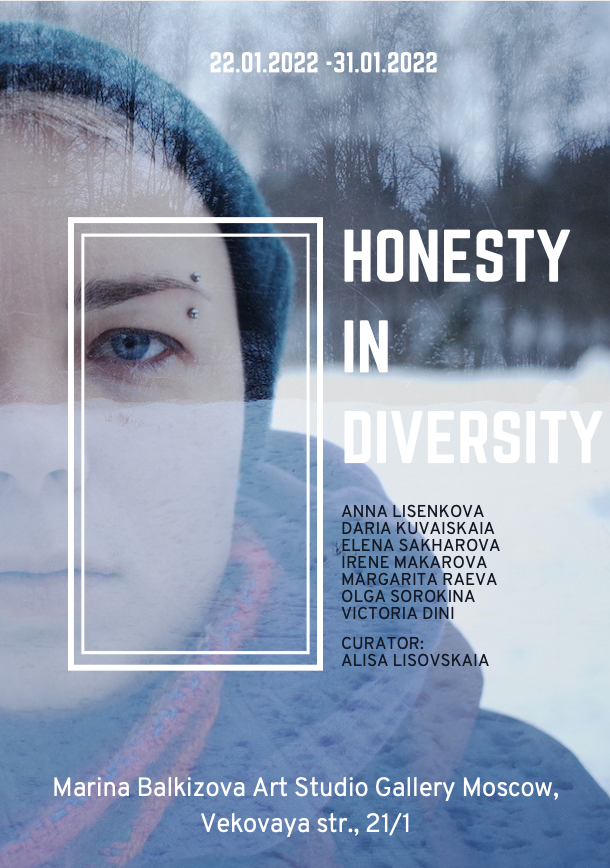Conversation on subjectivity. The exhibition ‘Honesty in diversity’
Nowadays the cultural shifts concern the social norms we live in and our perception of normality, tolerance, and self-esteem which have been changing due to the latest events happening in our country. We have no longer had a balanced everyday life, and our self-reflection undergoes the same rapid changes as the world does around us.

As the curator, Alisa Lisovkskaia has told us, the conception of the project Honesty in diversity was formulated some time ago as the aim was to highlight the works of female and gender non-conforming new media artists, artists working on examining their psychological health and the state of mind. For the exhibition, there were selected several different women artists talk about their perceptions of their identity, sexuality, and physicality. Interpretations of feminine vulnerability, trauma, a changing role of women in modern society, and the multiple self-identification of women are explored by the artists with a transparent and honest approach. The exhibition actualizes the interest in the archaic and traditional understanding of women in the society, in a nuclear family, and contextualizes her figure, making her a central figure of the nowadays society. The curatorial focus of the exhibition was made on the honest and open conversation of the artists with themselves and their self-reflection as a reaction to the latest events happening in Russia and around the world.

The painting Silence by Anna Lisenkova is a picture about the inner state of a woman, about self-love. The desire to surround yourself with beauty. The title reflects the essence and the idea the author had in mind while creating — ‘I love myself, I love peace and silence’ tells the girl which seems completely identical to nature, and her image harmoniously fits into the space around.
In her artwork Naked in Red Irene Makarova explores the theme of transformations that bring a person closer to his or her authenticity. According to the artist, it is the reliance on personal authenticity that helps to preserve human identity when external events lead to the dissolution of the usual cultural and human connections, which is especially relevant in the light of the events taking place in Russia and the world now. The figures in Irene‘s work symbolise maximum openness and freedom from rigidly determined social stereotypes and convey the experience of accepting oneself by accepting physicality. Irene uses oil painting to convey the complex and subtle states of physicality, the connection of physicality and the psychic, and the diversity of the shaky field of multiple elusive identities. Bright, open colours coexist and contrast with subtle, diverse colour modulations. Archetypal themes and figures in Irene‘s work convey the tense conflicts and challenges of the modern world symbolically and metaphorically.

Artwork #1 by Elena Sakharova represents the artist’s reflections on her desire for having honest and transparent relationships. The use of opaque colours is talking about her inclination to this transparency and the impossibility of achieving it. The figure between the two elements seems to be either active or petrified, but the red colour of the swimsuit gives hope for ignition and the ability to act. As the artist says, the foam for her is a forgotten Greek concept of melancholy, which was considered the regulating principle of the whole organism.
The works Parts unfixed I and Parts unfixed II by Margarita Raeva are represented as a diptych. Looking at these works of the artist, we witness chaotic whirlpools of objects enclosed in unnaturally bright spaces — so-called rooms. Here we can distinguish the parts of bodies intertwined with each other, fragments of faces, and geometric lines acting as a separate expressive accent. The choice of colour and the compositional solutions of these works translate a bit of aggressiveness and dynamics, which successfully corresponds to the theme that Margarita has been working with lately — the theme of constant change of human identity, a transformation of the outer shell and the inner, on the way to liberation from attachments and conventions. Using 3D graphics as a medium, the artist addresses another important theme of her practice — the digitalization of the body and the creation of alternative virtual entities, whose relationships and interrelationships may differ from those we construct in real life and thus act as a new layer of personality.

The Conversation by Olga Sorokina represents the forms, in which the most diverse visual components merge: from human, floral, and animal to mythological. Many biomorphic forms are seen as elusive derivatives of reality, both recognizable and unidentifiable. A common motif that emphasizes this connection between familiarity and ambiguity is the theme of closeness and vulnerability, not hidden, but manifested by the hybridity of the bodies depicted in the artist’s works.
Victoria Dini in her work Being (in love with) women explores lesbian relationships and through them the very notion of femininity beyond the imposed heteronormativity, beauty standards, and the obligatory cultural set of roles assigned to the woman in culture. Approaching the universe of the other persona and the ways of possible communication with this universe are the ideas explored by the artist.

In this triptych dedicated to Maurice Maeterlinck’s play Blue Bird Daria Kuvaiskaia decided to focus her attention on the image of the bird itself as a metaphor for one’s happiness and meaning of life. The artist shows that there is more than one possible interpretation of these concepts and for every person, it would be something different. Through her art, she critiques the unitarian approach to an individual in society and explores the role of a person in the transformation of the socio-cultural norms today.
The Honesty in diversity participants are the women artists who explore relationships with gender, physicality, and socio-cultural stereotypes regarding the women’s identity. An exceptional visual material presented by the emerging artists at the exhibition was picked to demonstrate a variety of feminine points of view and interpretations of these concepts.
Curator: Alisa Lisovskaia
Artists, artworks and media:
Anna Lisenkova — Silence (oil on canvas), 2021
Daria Kuvaiskaia — Birds (digital art), 2021
Elena Sakharova — #1 (mixed media), 2021-22
Irene Makarova — Naked in Red (oil on canvas), 2021
Margarita Raeva — Parts unfixed I, II (digital images), 2021
Olga Sorokina — Conversation (oil on canvas), 2021
Victoria Dini — Being (in love with) women (photography), 2020
